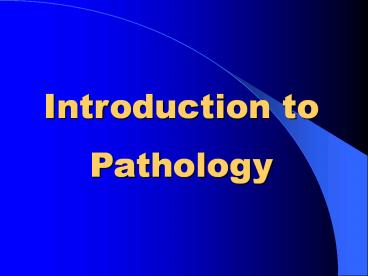Introduction to Pathology - PowerPoint PPT Presentation
Title:
Introduction to Pathology
Description:
Introduction to Pathology History of Pathology Autopsy Organ pathology (1761) LM Cellular pathology (1854) Ultrastructural pathology ... – PowerPoint PPT presentation
Number of Views:1808
Avg rating:3.0/5.0
Title: Introduction to Pathology
1
Introduction to Pathology
2
(No Transcript)
3
??History of Pathology
- Autopsy ? Organ pathology (1761)
- LM ? Cellular pathology (1854)
- Ultrastructural pathology with the application
- of EM (20 century 60s)
- Immunopathology, Molecular pathology,
- Genetic pathology, Quantitative pathology
4
??The scope of pathology
- 1. The core of pathology
- The four aspects of a disease process that
- form the core of pathology
- (1) Etiology causes of the disease
- (2) Pathogenesis the mechanisms of its
development - (3) Morphologic changes the structural
alteration - induced in the cells and organs
of the body. - (4) Clinical significance the functional
- consequences of the morphologic
changes.
5
2. Classification
Autopsy Biopsy Cytology
- (1) Human pathology
- (2) Experimental pathology
- 3. Position
- Its a bridging discipline involving both
- basic science and clinical practice
6
4. Text of Pathology
- (1) General pathology
- concerned with the basic reaction of
- cells and tissues to abnormal stimuli
- that underlie all diseases.
- (2) Systemic pathology
- dedcribe the specific responses of
specialized - organs and tissues to defined stimuli.
7
??Techniques of Pathology
- 1. Human pathology
- (1) Autopsy
- (2) Biopsy surgical or diagnostic pathology
- (3) Cytology smear, fine needle aspiration
- 2. Experimental pathology
- (1) Animal experiment animal model
- (2) Tissue and cell culture
8
(No Transcript)
9
??Observation and New Technique of
Morphology
- (?)Gross appearance
- size, shape
- weight
- color
- consistency
- surface
- edge, section
10
(?)Histologic and cytologic
observation
- most common and basic formalin fixed
- ? HE (hematoxylin and eosin) stained
Hemangioma of ventrical wall
11
(?)Histochemistry and cytochemistry
- PAS?BM
12
(?)Immunohistochemistry
- 1. Ag-Ab specific reaction
- 2. Applications
- (1) Location analysis
- cytokeratin?cell membrane
- (2) Clinical diagnosis and distinguishing
- diagnosis of tumor histogenesis
13
Leiomyosarcoma
Actin ()
14
(?)Ultrastructural observation
- TEM (transmitting electron microscope)
Filtering membrane
15
- SEM (scanning electron microscope)
Podocyte
16
(?)Flow cytometry (FCM)
- 1. One kind of cells?quantitative
- 2. DNA ploidy analysis
- 3. Protein nucleus acid?quantitative
-
analysis - 4. Selection of collection of cells
17
(No Transcript)
18
(No Transcript)
19
- (?)Image analysis (IA)
- Nuclei diameter circumference area
- volume morphology
- (?)Laser scanning confocal
- microscope (LSCM)
- aliving cell?observation in situ or
- development or
quantitative
20
(?)Molecular biology technique
- 1. Polymerase chain reaction (PCR)
- 2. DNA sequencing
- 3. Biochip technique
- (1) Gene chip (DNA chip)
- (2) Protein chip (protein microarray)
- (3) Tissue chip (tissue microarray)
21
Polymerase chain reaction (PCR)

